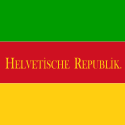
Back Helvetische Republik ALS الجمهورية الهيلفيتية Arabic Хелветска република Bulgarian República Helvètica Catalan Helvétská republika Czech Helvetische Republik German Ελβετική Δημοκρατία Greek Helveta Respubliko Esperanto República Helvética Spanish Helveetsia vabariik Estonian
This article has multiple issues. Please help improve it or discuss these issues on the talk page. (Learn how and when to remove these messages)
|
Helvetic Republic | |||||||||||||||
|---|---|---|---|---|---|---|---|---|---|---|---|---|---|---|---|
| 1798–1803 | |||||||||||||||
 The Helvetic Republic, with borders according to the first Helvetic constitution of 12 April 1798. Modern Swiss borders are outlined in orange. | |||||||||||||||
| Status | Client state of France | ||||||||||||||
| Capital | Aarau (1798) Lucerne (1798–1799) Bern (1799–1803)[1] | ||||||||||||||
| Official languages | French, German, Italian[2][3] | ||||||||||||||
| Other languages | Romansh, Lombard, Arpitan | ||||||||||||||
| Government | Directorial republic | ||||||||||||||
| Historical era | French Revolutionary Wars | ||||||||||||||
• Confederation collapsed on French invasion | 5 March 1798 | ||||||||||||||
• Proclaimed | 12 April 1798 | ||||||||||||||
• Elections in Zürich | 14 April 1798 | ||||||||||||||
• Mutual defence treaty with France | 19 August 1798 | ||||||||||||||
• Diplomatic recognition by French allies | 19 September 1798 | ||||||||||||||
• Malmaison constitution | 29 May 1801 | ||||||||||||||
• Federal constitution | 27 February 1802 | ||||||||||||||
| 19 February 1803 | |||||||||||||||
| Currency | Swiss franc | ||||||||||||||
| ISO 3166 code | CH | ||||||||||||||
| |||||||||||||||
Note: See below for a full list of predecessor states | |||||||||||||||
The Helvetic Republic (République helvétique (French); Helvetische Republik (German); Repubblica Elvetica (Italian); Republica helvetica (Romansh)) was a sister republic of France that existed between 1798 and 1803, during the French Revolutionary Wars. It was created following the French invasion and the consequent dissolution of the Old Swiss Confederacy, marking the end of the ancien régime in Switzerland.[4] Throughout its existence, the republic incorporated most of the territory of modern Switzerland, excluding the cantons of Geneva and Neuchâtel and the old Prince-Bishopric of Basel.[1]
The Swiss Confederacy, which until then had consisted of self-governing cantons united by a loose military alliance (and ruling over subject territories such as Vaud), was invaded by the French Revolutionary Army and turned into an ally known as the "Helvetic Republic". The interference with localism and traditional liberties was deeply resented, although some modernizing reforms took place.[5][6] Resistance was strongest in the more traditional Catholic cantons, with armed uprisings breaking out in spring 1798 in the central part of Switzerland. The French and Helvetic armies suppressed the uprisings, but opposition to the new government gradually increased over the years, as the Swiss resented their loss of local democracy, the new taxes, the centralization and the hostility to religion. Nonetheless, there were long-term effects to the Helvetic citizens.[7]
The Republic's name Helvetic, after the Helvetii, the Gaulish inhabitants of the Swiss Plateau in antiquity, was not an innovation; rather, the Swiss Confederacy had occasionally been dubbed Republica Helvetiorum in humanist Latin since the 17th century, and Helvetia, the Swiss national personification, made her first appearance in 1672.[citation needed] In Swiss history, the Helvetic Republic represents an early attempt to establish a centralized government in the country.
- ^ a b Helvetic Republic in German, French and Italian in the online Historical Dictionary of Switzerland.
- ^ The constitution of the Helvetic Republic Archived 8 June 2021 at the Wayback Machine, as described in the Historical Dictionary of Switzerland.
- ^ Ayres-Bennett, Wendy; Carruthers, Janice (2018). Manual of Romance Sociolinguistics. De Gruyter. p. 529. ISBN 9783110365955. Archived from the original on 8 December 2021. Retrieved 17 November 2021.
- ^ Lerner, Marc H. (2023), "Switzerland: Local Agency and French Intervention: The Helvetic Republic", The Cambridge History of the Age of Atlantic Revolutions, vol. 2, Cambridge University Press, pp. 303–328, doi:10.1017/9781108599405.015, ISBN 978-1-108-47598-3
- ^ Marc H. Lerner, "The Helvetic Republic: An Ambivalent Reception of French Revolutionary Liberty," French History (2004) 18#1 pp 50–75.
- ^ R.R. Palmer, The Age of the Democratic Revolution 2:394-421
- ^ Otto Dann; John Dinwiddy (1988). Nationalism in the Age of the French Revolution. Continuum. pp. 190–98. ISBN 9780907628972. Archived from the original on 30 April 2016. Retrieved 12 November 2015.


